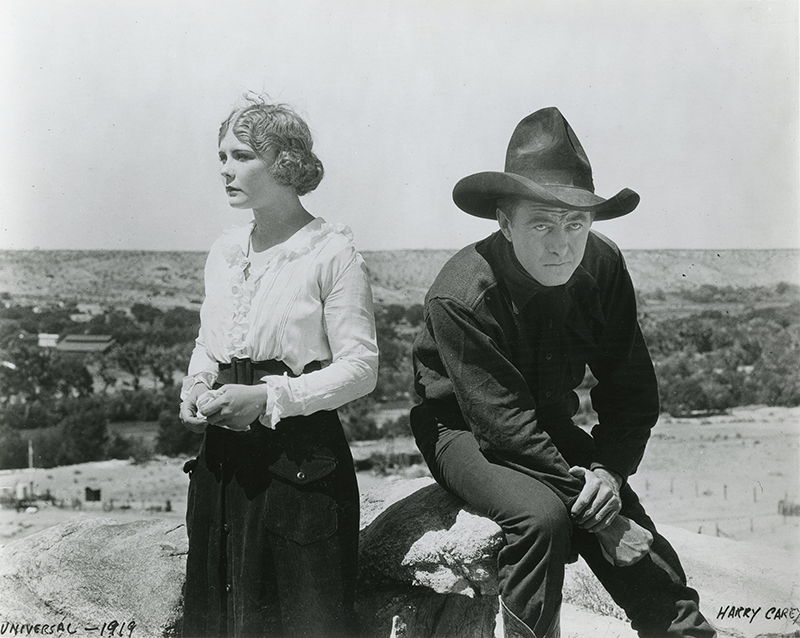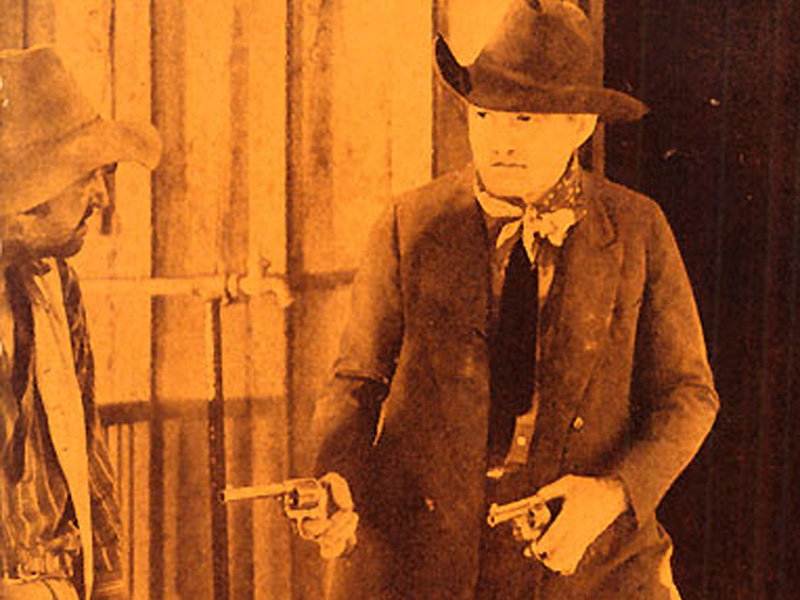|
|


Click image to enlarge
Saugus rancher Harry Carey Sr. (right) returns as "Cheyenne Harry" opposite Winifred Westover (left) — the future Mrs. William S. Hart — in the 1919 John Ford Western, "Marked Men." "Cheyenne Harry" was a role Carey played a few times for Ford, including two years earlier in "Straight Shooting," which used Beale's Cut and the Oak of the Golden Dream as locations. "Marked Men" was Westover's next vehicle following "John Petticoats," a Lambert Hillyer picture in which she played opposite Hart. "John Petticoats" was released November 2, 1919; "Marked Men" followed on December 21, 1919. Westover and Hart wed two years later. "Marked Men" is a lost film, as are many pictures from the silent era, so we don't know much about it. Back in the day, the studios weren't particularly good about getting their film prints back from movie theaters, and even when they did, occasionally the nitrate film would degrade and explode and take the studio's entire film vault with it. It might seem odd that that a picture by one of Hollywood's most famous directors, featuring a big star like Harry Carey, would be lost, but it's not the only one. Another John Ford picture with an actor who would become an even bigger star, Tom Mix, is gone, as well. All that's left of "Three Jumps Ahead" are some still images of Mix jumping over Beale's Cut — or not. It was a favorite Ford location. He used it at least four times (counting the insert in 1939's "Stagecoach" with John Wayne), maybe more; with lost films, we'll never really know how many times he used it. "Marked Men" was written by Peter B. Kyne (story) and H. Tipton Steck (screenplay). Kyne also wrote "3 Godfathers," which Ford turned into a motion picture in 1948 starring Carey's son, Harry Carey Jr., together with John Wayne and Pedro Armendariz. Also appearing in "Marked Men" are J. Farrell MacDonald, Joe Harris, Ted Brooks, Charles Le Moyne and David Kirby (uncredited). The producer is Pat A. Powers; cinematography by John W. Brown; edited by Frank Atkinson and Frank Lawrence. 50 minutes (5 reels).
About Harry Carey Sr. Actor Harry Carey (Sr.) acquired a homestead at the mouth of San Francisquito Canyon in 1916 and established a rancho. The ranch included the Carey's wooden ranch home as well as several outbuildings and the Harry Carey Trading Post, which was a tourist attraction that included billed entertainment from Navajo Indians and other performers, along with a store that sold Western and Indian curios. The ranch was occasionally used for filming. The Careys' son, Harry Carey Jr. (Dobe), who would follow in his father's acting footsteps, was born in the Carey ranch home in 1921. The trading post washed away in the St. Francis Dam disaster of March 1928 and was not rebuilt. The Indians left about a month earlier, son Dobe said in a 2005 interview. Dobe said a shaman saw "a big crack and predicted it would break." The ranch house was situated at a higher elevation and survived the flood, only to burn down in 1932. The Careys replaced it by building a Spanish adobe home, which they sold with the rancho in 1945. Harry Carey was born Henry DeWitt Carey II on January 16, 1878 on 116th Street in the Bronx section of New York City. His father was a special-sessions judge and president of a sewing machine company. Harry attended a military academy but declined an appointment to West Point, instead trying his hand as a playwright. According to the Internet Movie Database: In 1911, his friend Henry B. Walthall introduced him to director D.W. Griffith, for whom Carey was to make many films. Carey married twice [correx: 3 times; see here], the [third] time to actress Olive Fuller Golden (aka Olive Carey), who introduced him to future director John Ford. Carey influenced Universal Studios head Carl Laemmle to use Ford as a director, and a partnership was born that lasted until a rift in the friendship in 1921. During this time, Carey grew into one of the most popular Western stars of the early motion picture, occasionally writing and directing films as well. In the 1930s he moved slowly into character roles and was nominated for an Oscar for one of them, the president of the Senate in "Mr. Smith Goes to Washington" (1939). He worked once more with Ford, in "The Prisoner of Shark Island" (1936), and appeared once with his son, Harry Carey Jr., in Howard Hawks' "Red River" (1948). He died Sept. 21, 1947, in Brentwood, after a protracted bout with emphysema and cancer. Ford dedicated his remake "3 Godfathers" (1948) "To Harry Carey — Bright Star Of The Early Western Sky." Carey would appear in at least 233 films, including short features, between 1909 and 1949. Further reading: Harry Carey Ranch: Historic American Buildings Survey No. CA-2712.
LW3193: 9600 dpi jpeg from 8x10 copy print purchased 2018 by Leon Worden.
|
FULL MOVIE:
Broken Ways 1913
FULL MOVIE 1938
Fan Reply Card <1928
Marriages
Marked Men 1919
A Fight for Love 1919
Harry & Olive 1919
Overland Red 1920
Canyon of the Fools 1923
The Seventh Bandit 1926 (Mult.)
Satan Town 1926
Burning Bridges 1928
Trader Horn 1931
The Vanishing Legion 1931 (Mult.)
The Devil Horse 1932
Rustler's Paradise 1935
Last of the Clintons 1935
Port of Missing Girls 1938
With U.S. VP John Garner 1940
The Shepherd of the Hills 1941 (Mult.)
Hollywood Walk of Fame
Nat Levine 1988
|
The site owner makes no assertions as to ownership of any original copyrights to digitized images. However, these images are intended for Personal or Research use only. Any other kind of use, including but not limited to commercial or scholarly publication in any medium or format, public exhibition, or use online or in a web site, may be subject to additional restrictions including but not limited to the copyrights held by parties other than the site owner. USERS ARE SOLELY RESPONSIBLE for determining the existence of such rights and for obtaining any permissions and/or paying associated fees necessary for the proposed use.























